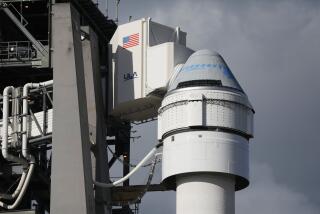Ex-Shuttle Chief Sees Flight Safety Put in Jeopardy
- Share via
WASHINGTON — The former chief of the nation’s space shuttle program, speaking publicly for the first time since leaving his job last week, said that the National Aeronautics and Space Administration is jeopardizing flight safety in its effort to restructure the program.
Bryan O’Connor, space shuttle director at NASA headquarters for the last four years, said in an interview that a plan to shift management control--transferring shuttle authority from headquarters here to the Johnson Space Center in Houston--contradicts reforms enacted 10 years ago in the wake of the shuttle Challenger disaster.
“It is a safety-related issue,” said O’Connor, a former Navy test pilot and shuttle astronaut. “We ran it this way for 10 years without a mishap and I didn’t see any reason why we should go back to the way we operated in the pre-Challenger days.”
NASA Chief Daniel S. Goldin ordered the restructuring to move shuttle executives closer to the day-to-day mission planning and administration of the program, said Geoffrey Vincent, a spokesman at NASA headquarters.
Vincent said the problems that existed before the Challenger exploded after lifting off in January 1986, killing all seven crew members aboard, no longer are relevant and that the restructuring plan will not undermine shuttle safety. The plan, he said, was endorsed by other senior managers after O’Connor expressed his concerns.
O’Connor’s resignation and his publicly expressed safety concerns are unprecedented in the agency’s history, according to experts. While other officials have fought quietly over safety issues in recent years and quit in protest, the battles have remained out of public view.
O’Connor’s comments also reflect a widespread and growing unease with the rapid changes that NASA is pushing, including laying the groundwork for turning the shuttle operation over to private managers.
The agency has cut the space shuttle work force by nearly one-third over the last four years and has pared its budget sharply while maintaining the same number of flights.
Goldin has said that a bloated work force is no guarantee of safety. In Goldin’s view, NASA must work faster, better and cheaper but still make safety its top priority.
Those goals have won praise, given the severe political pressure on NASA’s overall budget, but experts inside and outside NASA have expressed fear that the agency is taking risks that could severely damage the space program.
“They are drastically cutting back the number of people in the safety and quality assurance program,” said John Pike, a space expert at the Federation of American Scientists, a watchdog group that specializes in government science and technology programs. “There has been erosion of safety.”
Under Goldin’s restructuring plan, the Johnson Space Center would control the shuttle program and direct shuttle activities at NASA centers in Alabama, Florida and Mississippi.
“It was a situation where Goldin decided this was the way he wanted the agency managed,” Vincent said of the disagreement with O’Connor.
The Challenger commission, which was convened in 1986 to investigate the Challenger disaster, concluded that NASA’s far-flung empire of spaceflight centers had become fiefdoms that were operating outside strict control from Washington. The commission found that the responsibility for ensuring safety was diffused among the centers, allowing the agency to stumble into the erroneous decision to launch the Challenger in adverse cold conditions.
The commission recommended that NASA headquarters run the space shuttle program to ensure that one center did not disregard the directives of a rival center or attempt to withhold information.
Goldin apparently did not consult with important members of the Challenger commission before making the decision, several commission members said.
“The question is, are we heading back into the swamp? I don’t think the answer is clear,” said Albert Wheelon, a member of the Challenger commission. “What was clear at the time was that these centers were like independent city, states, and that needed fixing. Whether it has been fixed enough since then to go back to the old system remains to be seen.”
O’Connor said he is concerned that the arrangement might again lead to what he called structural secrecy, in which rivalry impedes the open sharing of information crucial to safety.
O’Connor said that he has supported streamlining the shuttle program, in which the work force has been cut from about 34,000 employees in 1992 to 24,000 today. The budget dropped to $3.2 billion this year from $4.6 billion in 1992. Over the same period, the agency has been operating about eight flights a year.
O’Connor said that he endorsed the NASA plan to select a single prime contractor to take over many of the day-to-day shuttle operations but drew the line at handing control back to Johnson.
“It was a black-and-white issue with me,” O’Connor said. “There was a lot of speculation that my leaving had to do with going to a single prime contractor on the program. I could live with that stuff. But not this one.”
O’Connor has won many supporters in Congress and industry during his four-year tenure as shuttle director. A senior staff member on the House Science Committee said: “The committee has great confidence in O’Connor.”
The staff member, as well as others, dismissed any suggestion that O’Connor was protecting turf by protesting the reorganization. The subcommittee plans to question Goldin on the matter at a budget hearing on March 28, the staff member said.
Pike said that at least two other senior NASA managers have quietly quit in the last few years, reportedly because of safety concerns.
Jose Garcia, a NASA manager at the Kennedy Space Flight Center in Florida with 30 years of experience, wrote a letter to President Clinton last August, asserting that the shuttle restructuring was undermining safety and that many people were exiting in protest.
More to Read
Sign up for Essential California
The most important California stories and recommendations in your inbox every morning.
You may occasionally receive promotional content from the Los Angeles Times.











